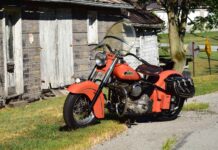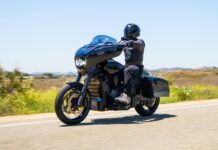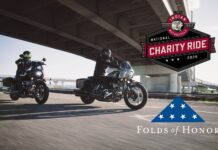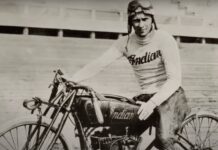DAYTONA BEACH, FLA., MAR. 9-17–You’d be hard pressed while attending Daytona Bike Week this year to not somehow be touched by the unveiling of Indian Motorcycle’s new proprietary motor that has been under development since Indian was acquired by Polaris Industries in April 2011. That whirlwind relationship has been under a lot of scrutiny due to the up-and-down history of the Indian marque since the original manufacturer went belly up in 1953. And now, after 60 years, the company seems on the brink of finally securing both the engineering resources and the deep pockets required for a possible successful reincarnation of this iconic piece of American motorcycling history. Being fully entrenched in three central locations during Bike Week, Indian Motorcycle pulled out all the stops to make the biggest splash possible. And their efforts got everyone wet.

Indian has been tantalizing the consumer’s interest over the last few months—releasing snippets of details; first a new motor, followed by the chance to hear (but not see) that motor. While this hype seemed bizarre, the strategy apparently paid off with the public interest rising and waiting for the promised engine unveiling during Daytona Bike Week (but… like a tantalizing strip tease, just the motor and not a complete bike). This next stage came together the first Saturday of Bike Week at Dirty Harry’s on Main Street. The place was packed and included motorcycle luminaries, members of the press and even Mike Wolf on center stage. Wolf is the co-star of the History Channel’s reality show American Pickers and is a spokesperson for, and huge fan of, Indian Motorcycles. While some had hoped for a more exotic design (like an inline 4), most comments centered on a “work of art.” And it is a very pretty motor. For those not in Daytona Beach, Indian blasted social media outlets with constant updates and photos—a hand well-played.
Main Street was a hub of activity during Bike Week, as Indian set up headquarters in a building that been renovated especially for displaying a cutaway model of the Thunder Stroke 111. It was there that engineer and chief designer Eric Fox held court, acting like a proud father, more than willing to answer all questions. The Thunder Stroke 111 is a 49-degree, unit construction V-twin that produces 115 ft lbs of torque. It uses a one-piece, forged single-pin crankshaft with side-by-side connecting rods and bottom yoke-bearing caps. A central single cam operates both intake valves, while two outer cams drive the exhaust valves. The intake cam is chain driven with both exhaust cams being gear driven off the intake cam. The placement of the cam package allows for a centralized mass, a crankshaft that is 2″ lower than anything comparable and an overall reduction in motor height. Hydraulic lifters actuate hollow pushrods that pump oil up their core for additional valve train lubrication.

The engine is solid mounted, with a cam and saddle torque converter coming off the left side of the motor and feeding power via primary drive gears through a six-plate spring-dampened clutch, to the six-speed overdrive constant mesh transmission. Power to the rear wheel is accomplished via a right-side belt. Patterned to resemble the historic 1948 Indian Chief 80″ flathead, what at first appears to be finned rocker arm housings are simply covers that bolt onto the head and allow an airflow between the two. In keeping with the desire to emulate that classic ’48 flattie, the exhaust ports are down-firing. This configuration of the exhaust was simply aesthetic, giving a nod to the company’s rich heritage. When questioned about the logic of using such a design whose curvature is certain to cause higher heat buildup, Fox reassures that the deep cooling fins in those two sections of the head easily compensate for any additional heat.
The Thunder Stroke uses a semi-dry sump and integrated oil cooler mounted up front. A large cavity behind and under the tranny serves as an oil reservoir, holding five and a half quarts of 20-40W synthetic. That oil is mutually used to lubricate the motor, transmission and primary drive gears. Not a common system in the V-twin world, but one that Fox stands behind after extensive testing and trials. A 54mm fully sequential EFI (with fly-by-wire controls) features an active knock control that automatically retards the spark when crappy gas is all that’s available.
But the question begged to be asked was, “Why 111”?” Eric grinned big and replied, “Just to give Harley a nudge. To see where they’ll go next.” It was an obvious reference to H-D’s 110″ CVO line.

At the Daytona Speedway, the Indian Motorcycle demo truck was busy all week, but not just handing out keys. Because there actually was a bike equipped with the new Thunder Stroke 111, but not a model you will ever get to pilot. In front of the demo truck was the Spirit of Munro, a recently commissioned land-speed racer named for the legendary Burt Munro. In 1967 Munro set the all-time land-speed record for a motorcycle under 1000cc when he took his special-constructed 1920 Indian Scout down the salt at 183.586 mph in Bonneville. This new aluminum-skinned torpedo was designed by Jeb Scolman of Jeb’s Metal and Speed in Long Beach, California, and houses an almost completely obscured Thunder Stroke hidden within its hull. It was a great photo op.
The third location where you could catch a glimpse of the next generation of Indian’s powerplant may have been the best one of all. In the lot of Destination Daytona, outside Bruce Rossmeyer Harley-Davidson, a large tent displayed several motors and complete bikes from the early years of the company. Bolted to a special stand, the motor that was unveiled on Saturday night was the main attraction. But no touching allowed. No, they weren’t worried about fingerprints. This baby was oiled and gassed and as the sign taped to it stated, “DO NOT TOUCH—Hot Motor.” It was live and ready to be fired and once you heard it, you would have to agree—it is one hot motor. And each time the operator felt the timing was right and the crowd was the size needed for maximum exposure, he would fire up this monster to the delight of all. With the character of a high-bred European sports car motor, this elegant beast was responsive, smooth and, most of all, loaded with expectations of unbridled performance. This was a demonstration that everyone enjoyed.

So we have the motor. How about the complete package? After filtering lots of vaguely answered questions and doing a little reading between the lines, don’t be shocked if there’s a big surprise during the Sturgis rally this year. Let’s just hope it’s worth the wait. ’Cause it’s been fun so far.


















